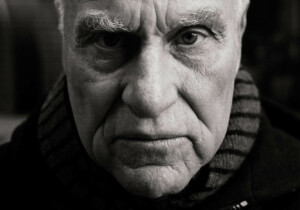Artist Ilya Iossifovich Kabakov, a primary figure in the Russian (or Moscow) Conceptualist movement, died at age 89 on May 27. Kabakov was born into a Jewish family in Dnipropetrovsk, Ukrainian Soviet Socialist Republic (present-day Ukraine), in 1933, and spent part of his childhood in Samarkand in the Uzbek Soviet Socialist Republic (now Uzbekistan) after being evacuated there in World War II. It was in Samarkand that Kabakov began his formal artistic education, studying at the relocated Leningrad Academy of Art.
Kabakov moved to Moscow after the war, studying graphic design and book illustration at the Surikov State Art Institute before joining the Soviet Artists’ Union in 1959. While Kabakov worked as a book illustrator in the following years, he would later become known for his underground artistic work from his participation in Moscow’s Conceptualism circle. Hosting artists like Dmitri Prigov and Erik Bulatov in his studio, Kabakov gained underground prominence during a flourishing period of dissident art particularly in the period following the Bulldozer Exhibition (which Kabakov did not participate in).
In 1987, Kabakov emigrated to the United States, living the rest of his life on Long Island and working with his wife, Emilia. His first American exhibition, Ten Characters, was unveiled at Ronald Feldman Gallery in 1988, showing his installation work and quickly raising the artist’s profile in the West. Ten Characters depicted the rooms of ten inhabitants of two kommunalkas, showing their personal lives in an exploration of personal and mundane experiences in Soviet life—thematically characteristic of much of Kabakov’s work. The exhibition famously included The Man Who Flew Into Space From His Apartment, in which one of the rooms, clad in political posters, with a giant hole in the ceiling from which a slingshot-like device is suspended. In 1993, Kabakov’s permanent installation School No. 6, which turned an existing building into a scene reminiscent of a schoolhouse from the early days of the Soviet Union, opened at the Chinati Foundation.
Not to be conflated with Western postmodernism, Kabakov’s art often depicted absurd scenarios and incorporated cosmic themes across over 50 albums of illustrations. It was from these that he and Emilia made over 150 installation works. This includes The Red Pavilion, exhibited at the 1993 Venice Art Biennale, and the utopian vision Strange City, first exhibited at Paris’s Grand Palais in 2014. The Kabakovs’ first major exhibition in Russia, An Incident in the Museum and Other Installations, was shown at the State Hermitage Museum in St. Petersburg in 2004.
Prior to Ilya’s death, the Kabakovs received retrospective exhibitions at Tate Modern (Not Everyone Will Be Taken Into The Future), which was also shown at the Hermitage and the Tretyakov Gallery in Moscow. A large selection of pieces were also shown at the Hirshhorn Museum in Washington, D.C. (Utopian Projects) in 2017. The Kabakovs’ work is held by a number of prominent institutions, including the Museum of Modern Art, the Guggenheim, Centre Pompidou, the Hermitage, and the Tretyakov.











